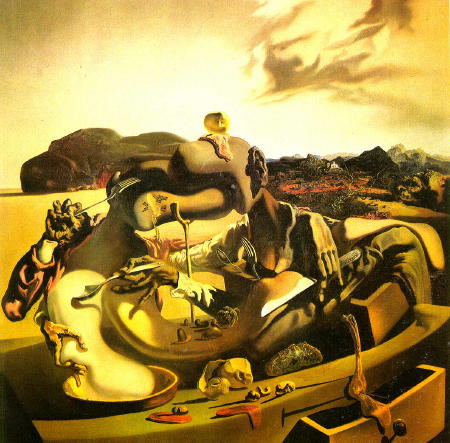“Take this country back by force!”
While the phrase brings only 13 Google hits, earlier I heard a man say that, and while he might have merely been venting because of a bad hair day, he sounded awfully serious. (There are so many assumptions within the demand that if I wanted to analyze it I wouldn’t know where to begin.)
I know it sounds nutty to be worred about civil war, but sometimes I think it’s the nature of man. Not just in the nature of Iraqis, Chileans, Bosnians, Salvadorans, etc.
Chester’s “Autumn of the Patriarch” post (about Frederick Turner’s piece on Iraqi death squads), made me think again about Dali’s “Soft Construction with Boiled Beans” painting. Here’s Chester:
Turner believes that death squads are a sort of primeval slime from which governments emerge. But might they not also be the maggots that feast on their corpses? Perhaps the true victim of such squads and other proxies is the state itself, so long the leviathan that its demise is now both impossible to imagine and futile to escape.
(Via Glenn Reynolds.)
However, and much as I hate to be a relativist, considering the number of people killed by governments (156,000,000 in the 20th Century), perhaps even civil war needs to be seen in perspective.
Or is that a distinction without a difference? Whether it’s civil war or a government killing its citizens, such slaughters are usually perpetrated by one group of people killing another group of their fellow countrymen. Whether it’s the government that’s doing the killing or a faction that wants to become the government, when citizens of a country massacre each other, it’s metaphorically cannibalism.
And speaking of both autumn and cannibalism, here’s Dali’s “Cannibalism in Autumn”:

Painted shortly after the Soft Construction/Premonition painting, it’s a continuation of Dali’s treatment of the civil war theme.
While the topic at hand was obviously the Spanish Civil War, Dali was thinking about the bigger picture, including natural history.
Dali offered a much criticized explanation of the painting:
“These Iberian beings devouring each other in the autumn express the pathos of civil war considered as a phenomenon of natural history, as distinct from Picasso, who considered it a political [phenomenon.]”
Hmmm….
Is politics an excuse for cannibalism?
I guess it depends on who’s eating whom.
Yesterday I spent a couple of hours seeing the Franklin Institute’s Darwin exhibition, and I can’t stop thinking about one of his observations:
“Man tends to increase at a greater rate than his means of subsistence; consequently he is occasionally subjected to a severe struggle for existence, and natural selection will have effected whatever lies within its scope.”
I’d hate to think mass slaughter of human beings might be grounded in natural law.
That might lead to people to hate natural law, man’s nature, Darwin, or even God. But it wouldn’t stop the process.
As Trotsky is reported to have said, “you may not be interested in war, but war is interested in you.”
Comments
One response to “fine young autumn for nature’s cannibals”
It seems like a lot of people are getting bogged down in the silly question: “Is the war in Iraq a ‘Civil War’?” I think this is because most Americans think of the American Civil War when they hear the term ‘civil war’. In the American Civil War, there were 2 governments, each with its own army. What is going on in Iarq is not like that kind of civil war. However, many civil wars are not so neat. Many civil wars have multiple factions fighting, like the Mexican civil War, which Mexicans call ‘The Revolution.” That civil war went on from around 1910 to 1920, and a million people were killed. It was a messy civil war, with many factions. I think Iraq is in a civil war, a messy one, but still a civil war.